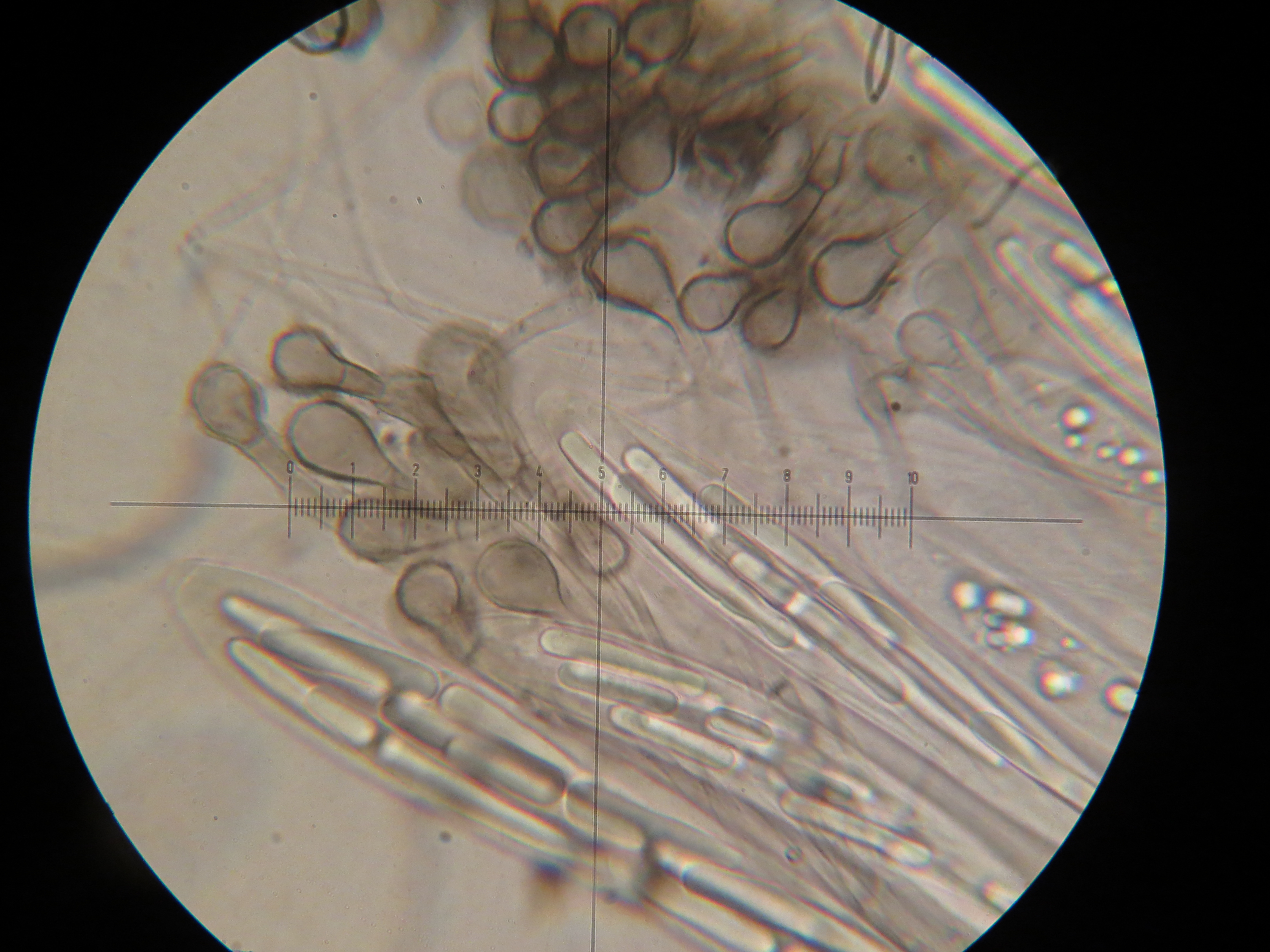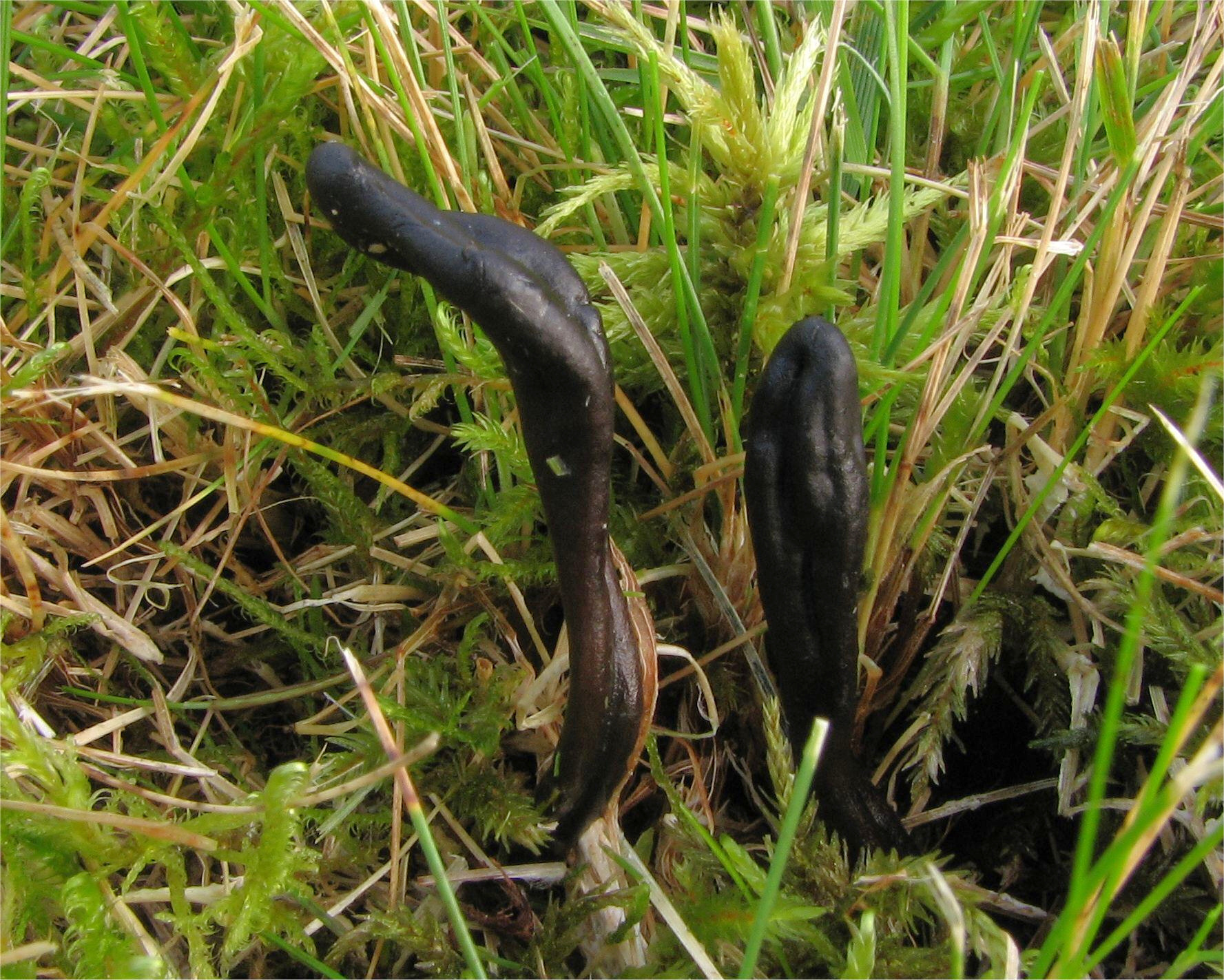Glutinoglossum Glutinosum on:
[Wikipedia]
[Google]
[Amazon]
''Glutinoglossum glutinosum'', commonly known as the viscid black earth tongue or the glutinous earthtongue, is a species of
 The spores are smooth and cylindrical, sometimes with a slight swelling in the middle, and sometimes slightly curved; they measure 59–65 by 4–5 µm. ''G. glutinosum'' spores have between two and seven
The spores are smooth and cylindrical, sometimes with a slight swelling in the middle, and sometimes slightly curved; they measure 59–65 by 4–5 µm. ''G. glutinosum'' spores have between two and seven
 ''Glutinoglossum glutinosum'' is a
''Glutinoglossum glutinosum'' is a
fungus
A fungus ( : fungi or funguses) is any member of the group of eukaryotic organisms that includes microorganisms such as yeasts and molds, as well as the more familiar mushrooms. These organisms are classified as a kingdom, separately from t ...
in the family Geoglossaceae (the earth tongues). Widely distributed in the Northern Hemisphere, it has been found in northern Africa, Asia, Europe, and North America. Although previously thought to exist in Australasia, collections made from these locations have since been referred to new species. ''G. glutinosum'' is a saprophytic
Saprotrophic nutrition or lysotrophic nutrition is a process of chemoheterotrophic extracellular digestion involved in the processing of decayed (dead or waste) organic matter. It occurs in saprotrophs, and is most often associated with fungi ( ...
species that grows on soil in moss or in grassy areas. The smooth, nearly black, club-shaped fruitbodies grow to heights ranging from . The head is up to long, and the stipes are sticky. Several other black earth tongue species are quite similar in external appearance, and many can be reliably distinguished only by examining differences in microscopic characteristics, such as spores
In biology, a spore is a unit of sexual or asexual reproduction that may be adapted for dispersal and for survival, often for extended periods of time, in unfavourable conditions. Spores form part of the life cycles of many plants, algae, ...
, asci, and paraphyses. First described in 1796 as a species of '' Geoglossum'', the fungus has gone through several changes of genera in its taxonomic history. It was placed in its current genus, '' Glutinoglossum'', in 2013.
Taxonomy
The fungus was first officially described in 1796 as ''Geoglossum glutinosum'' by Dutch mycologist Christiaan Hendrik Persoon, who proposed several defining characteristics, including the black color; the smooth, compressed, club-shaped head (''clavula'') with grooves; and the somewhat curved and glutinous stipe. In 1908, Elias Judah Durand transferred it to ''Gloeoglossum'', a genus he circumscribed to contain species with paraphyses (filamentous, sterile cells interspersed between the asci) present as a continuous gelatinous layer on the stipe; ''Gloeoglossum'' has since been reduced tosynonymy
A synonym is a word, morpheme, or phrase that means exactly or nearly the same as another word, morpheme, or phrase in a given language. For example, in the English language, the words ''begin'', ''start'', ''commence'', and ''initiate'' are all ...
with ''Geoglossum''. In 1942 Japanese mycologist Sanshi Imai thought the species should be in ''Cibalocoryne'', a genus name used earlier by Frigyes Ákos Hazslinszky, and so published ''Cibalocoryne glutinosa''. Later authors thought ''Cibalocoryne'' to be ambiguous, and the name was synonymized with ''Geoglossum''. Persoon also described the species ''Geoglossum viscosum'' (1801) and the variety
Variety may refer to:
Arts and entertainment Entertainment formats
* Variety (radio)
* Variety show, in theater and television
Films
* ''Variety'' (1925 film), a German silent film directed by Ewald Andre Dupont
* ''Variety'' (1935 film), ...
''Geoglossum glutinosum'' var. ''lubricum'' (1822), but both of these taxa were placed into synonymy with ''G. glutinosum'' by Elias Judah Durand in 1908.
The species was transferred by Vincent Hustad and colleagues to the newly created genus '' Glutinoglossum'' in 2013 when molecular analysis revealed that it and the species '' G. heptaseptatum'' formed a well-defined clade in the Geoglossaceae. In 2015, Hustad and Andrew Miller published an emended description of ''G. glutinosum'' with a narrower range of spore dimensions, suggesting that material collected in Australia and New Zealand represent unique species, which they referred to '' G. australasicum'' and '' G. exiguum''. These species, along with '' G. americanum'' and '' G. methvenii'', were added to ''Glutinoglossum'' in 2015. Hustad and Miller noted their new spore size range for ''G. glutinosum'' were more closely aligned with those given by Durand in his measurements of Persoon's type specimen
In biology, a type is a particular specimen (or in some cases a group of specimens) of an organism to which the scientific name of that organism is formally attached. In other words, a type is an example that serves to anchor or centralizes th ...
.
The specific epithet ''glutinosum'' is derived from the Latin
Latin (, or , ) is a classical language belonging to the Italic branch of the Indo-European languages. Latin was originally a dialect spoken in the lower Tiber area (then known as Latium) around present-day Rome, but through the power of the ...
word ''gluten'', meaning "glue". The species is commonly known as the "viscid black earth tongue" or the "glutinous earthtongue".
Description
The club-shaped fruitbodies, which have a distinct blackish head and a more lightly colored stipe (dark brown), grow to heights ranging from . The head is up to tall and ranges in shape from fuse-shaped to narrowly ellipsoidal to nearly cylindrical, and is somewhat compressed on the sides. The nearly black, somewhat waxy head has a vertical groove down the middle. The stipe has a glutinous, dark grey-brown surface. The spores are smooth and cylindrical, sometimes with a slight swelling in the middle, and sometimes slightly curved; they measure 59–65 by 4–5 µm. ''G. glutinosum'' spores have between two and seven
The spores are smooth and cylindrical, sometimes with a slight swelling in the middle, and sometimes slightly curved; they measure 59–65 by 4–5 µm. ''G. glutinosum'' spores have between two and seven septa
The Southeastern Pennsylvania Transportation Authority (SEPTA) is a regional public transportation authority that operates bus, rapid transit, commuter rail, light rail, and electric trolleybus services for nearly 4 million people in five c ...
, although three is most typical in mature specimens. The thin-walled asci (spore-bearing cells) are cylindrical to narrowly club-shaped, eight-spored, and typically measure 200–265 µm long by 12–16 µm wide. Ascospores occupy about the upper two-thirds to three-quarters of the ascus, leaving a hyaline (transparent) base. The paraphyses, hyaline at the base and brown in the upper regions, are 4–11 µm wide, and longer than the asci. Cells at the end of the paraphyses are pear-shaped (piriform) or spherical, brownish, and measure 8–10 µm wide. The sticky material on the stipe is a gelatinous matrix made of a layer of paraphyses.
Although black earth tongue species are generally not worth eating, Charles McIlvaine opined in his 1902 work ''One Thousand American Fungi'' that, if stewed, ''G. glutinosum'' is "delicious."
Similar species
'' Geoglossum nigritum'' is similar in appearance to ''Glutinoglossum glutinosum'', but lacks a slimy stipe. '' Trichoglossum'' species, such as the common '' T. hirsutum'', have a velvety surface texture acquired from thick-walled bristles calledseta
In biology, setae (singular seta ; from the Latin word for " bristle") are any of a number of different bristle- or hair-like structures on living organisms.
Animal setae
Protostomes
Annelid setae are stiff bristles present on the body. ...
e. Several other earth tongue species are roughly similar in external appearance to ''G. glutinosum'', and can be difficult to distinguish from that species without considering distribution and microscopic characteristics such as the size and shape of the asci, ascospores, and paraphyses. '' Geoglossum peckianum'' and '' G. uliginosum'' can develop a glutinous stipe; the former has spores measuring 90–120 by 6–7 µm with 14 septa, while the latter has spores that are 60–80 by 4.5–6 µm with 7 septa. The Australasian species '' Glutinoglossum methvenii'' is distinguished from ''G. glutinosum'' by its short, stout ascospores (mostly measuring 70–80 by 5–6 µm) and the presence of curved to hooked paraphyses tips. '' G. australasicum'', the most abundant ''Glutinoglossum'' species in Australasia, has asci measuring 205–270 by 17–20 µm, while those of '' G. exiguum'' are 165–260 by 13.5–17 µm. The latter species tends to have smaller fruitbodies, up to tall.
Habitat and distribution
 ''Glutinoglossum glutinosum'' is a
''Glutinoglossum glutinosum'' is a saprophytic
Saprotrophic nutrition or lysotrophic nutrition is a process of chemoheterotrophic extracellular digestion involved in the processing of decayed (dead or waste) organic matter. It occurs in saprotrophs, and is most often associated with fungi ( ...
species. Its fruitbodies grow scattered on soil in moss beds or in grassy areas. North American collections are typically associated with hardwoods, while European collections are often made in pasture
Pasture (from the Latin ''pastus'', past participle of ''pascere'', "to feed") is land used for grazing. Pasture lands in the narrow sense are enclosed tracts of farmland, grazed by domesticated livestock, such as horses, cattle, sheep, or sw ...
and dune slack
An interdunal wetland, interdunal pond or dune slack is a water-filled depression between coastal sand dunes. It may be formed either by wind erosion or by dunal encroachment on an existing wetland. The wind erosion process involves wind scooping ...
s. The fungus has been used as an indicator of medium-quality grassland
A grassland is an area where the vegetation is dominated by grasses ( Poaceae). However, sedge ( Cyperaceae) and rush ( Juncaceae) can also be found along with variable proportions of legumes, like clover, and other herbs. Grasslands occur na ...
in the UK. In India, it has been encountered on the soil of oak forests, and among mosses on stony slopes at an elevation of .
A widely distributed species, ''Glutinoglossum glutinosum'' has been recorded from northern Africa (Macaronesia
Macaronesia (Portuguese: ''Macaronésia,'' Spanish: ''Macaronesia'') is a collection of four volcanic archipelagos in the North Atlantic, off the coasts of Africa and Europe. Each archipelago is made up of a number of Atlantic oceanic islands ...
), Asia (Bhutan, China, India, Japan, and the Philippines) and Europe. It is listed as vulnerable in Switzerland. In Bulgaria, where it is considered critically endangered, threats to ''G. glutinosum'' include "habitat changes as result of agriculture activities (crops, livestock), atmospheric and land pollution, drought, global warming." In a preliminary Regional Red List
A Regional Red List is a report of the threatened status of species within a certain country or region. It is based on the IUCN Red List of Threatened Species, an inventory of the conservation status of species on a global scale. Regional Red ...
of Dutch macrofungi, ''G. glutinosum'' was considered threatened
Threatened species are any species (including animals, plants and fungi) which are vulnerable to endangerment in the near future. Species that are threatened are sometimes characterised by the population dynamics measure of ''critical depensat ...
, and it was noted that before 1970, the fungus was "rather common", compared to "rather rare" after that year. The North American distribution includes Canada, the United States, and Mexico.
Although ''G. glutinosum'' was previously thought to have occurred in Australia and New Zealand, later examination and genetic analysis of collections from these locations showed the material to belong to what have since been described as the new species ''G. australasicum'' or ''G. exiguum''.
References
External links
* {{Good article Geoglossaceae Fungi described in 1796 Fungi of Africa Fungi of Asia Fungi of Europe Fungi of North America Fungi of Macaronesia